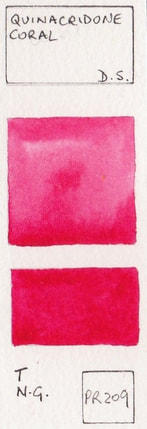Quinacridones
There is a wonderful family of colours that share the characteristics of transparency, vibrancy and permanence, and they are the quinacridones. They include Quinacridone Red, Quinacridone Rose, Quinacridone Pink, Quinacridone Purple, Quinacridone Violet, Quinacridone Sienna,
Quinacridone Burnt Orange, Quinacridone Gold, Quinacridone Burnt Scarlet, Quinacridone Gold Deep, Quinacridone Coral, Quinacridone Magenta, Quinacridone Fuchsia and Quinacridone Lilac in the Daniel Smith range, but are also produced by other manufacturers under a variety of names such as permanent rose, permanent magenta, transparent gold and so on. It is not necessary to have all of them, but a limited range expands the palette beautifully, especially if painting florals!
Quinacridone Gold is so useful I have included it in the warm yellow section as a primary yellow option as well. Some artists use this in place of Yellow Ochre or Raw Sienna. Quinacridone Sienna makes a lovely convenience orange, Quinacridone Rose and Quinacridone Violet are fabulous for making purples that glow, and Quinacridone Burnt Orange could be used to replace Burnt Sienna in a palette as it is also a neutralised orange.
You can see many different quinacridone colours in many brands in the Painted Watercolour Swatches tab. I have just included the Daniel Smith ones here as they were, I believe, the first to produce them and have the largest range.
Quinacridone Burnt Orange, Quinacridone Gold, Quinacridone Burnt Scarlet, Quinacridone Gold Deep, Quinacridone Coral, Quinacridone Magenta, Quinacridone Fuchsia and Quinacridone Lilac in the Daniel Smith range, but are also produced by other manufacturers under a variety of names such as permanent rose, permanent magenta, transparent gold and so on. It is not necessary to have all of them, but a limited range expands the palette beautifully, especially if painting florals!
Quinacridone Gold is so useful I have included it in the warm yellow section as a primary yellow option as well. Some artists use this in place of Yellow Ochre or Raw Sienna. Quinacridone Sienna makes a lovely convenience orange, Quinacridone Rose and Quinacridone Violet are fabulous for making purples that glow, and Quinacridone Burnt Orange could be used to replace Burnt Sienna in a palette as it is also a neutralised orange.
You can see many different quinacridone colours in many brands in the Painted Watercolour Swatches tab. I have just included the Daniel Smith ones here as they were, I believe, the first to produce them and have the largest range.
Pure bright purples - Quinacridone Rose + Ultramarine

Quinacridone Rose (left) mixed with Ultramarine blue (right).
The granulation is due to the properties of Ultramarine. If a smoother purple is needed, without granulation, use Phthalo Blue, Red shade.
Quinacridone Violet

Quinacridone Violet. Daniel Smith watercolour.
Also made with PV19. This is an example of PV19 at the other end of the scale. Wonderful for making purples with a warm blue such as ultramarine, but also makes amazing mixed purples with phthalo green!
Pure bright purples - Quinacridone Violet + Ultramarine

Pure purples are create with this mixture too. It is actually the same pigment - PV19 - in Quinacridone Rose and Violet.
Pure bright purples - Quinacridone Violet + Cobalt Blue

Quinacridone Violet with Cobalt Blue.
Another way to make pure bright purples.
Neutrals- Quinacridone Violet + Phthalo Green

Interesting purples with this mixture!
Neutralised oranges & reds- Quinacridone Violet + Cadmium Yellow Light

Quinacridone Violet (left) mixed with Cadmium Yellow Light (right).
Quinacridone Sienna.

Quinacridone Sienna. Daniel Smith watercolour.
A mixture of Quinacridone Gold (PO 49) and Quinacridone Yellow Red (PR 209) pigments, this is a wonderful natural looking orange. It makes beautiful neutrals with Ultramarine. Now reformulated and made with PO48 + PY150 + PR209.
Quinacridone Burnt Orange
Quinacridone Magenta

Quinacridone Magenta PR202 Daniel Smith
Daniel Smith make this colour with the lightfast pigment PR 202. It is another colour that can be used as a single red in a primary triad. Mixed with a mid to warm yellow it will create oranges and reds.
Most manufacturers use PR122 to produce Quinacridone Magenta - Schmincke (called Purple Magenta), Winsor & Newton, Daler Rowney, Old Holland and many others. It mixes to create brighter oranges than the PR202 version, as well as gorgeous purples so is a superb mixing red though the PR202 is a more powerful looking colour on its own.
Most manufacturers use PR122 to produce Quinacridone Magenta - Schmincke (called Purple Magenta), Winsor & Newton, Daler Rowney, Old Holland and many others. It mixes to create brighter oranges than the PR202 version, as well as gorgeous purples so is a superb mixing red though the PR202 is a more powerful looking colour on its own.
Quinacridone Burnt Scarlet

Quinacridone Burnt Scarlet, Daniel Smith. PR206
Made with PR206, this can replace Brown Madder in many palettes, or provide a transparent alternative to Indian Red. It is also a convenient colour to use for shadows in scarlet flowers.
Quinacridone Gold |
Quinacridone Gold Deep |
|
Quinacridone Gold is one of my favourite watercolours, and it is mentioned in the Warm Yellows section. The genuine PO49 version was only available from Daniel Smith until 2018. Now they, and other companies, make a hue using other pigments - usually PY150 as a base with either PR101 or PO48 being the best of them.
|
Like Quinacridone Burnt Orange, Quinacridone Gold Deep was originally made with PO48 as on the right but it is now made with PY150 + PO48. It is a deeper version of Quinacridone Gold just as raw sienna could be seen as a more neutral and more orange version of a yellow ochre.
|
Quinacridone Purple |
Quinacridone Coral |
Quinacridone Lilac
|
The newest addition to the Quinacridone range.
Quinacridone Lilac is made from PR122. It is often called Quinacridone Magenta, but DS already had that (see above) This is a fabulous primary red if you are searching for a CYMK palette, though in painting I prefer the Rose to the magenta as a basic colour. |









